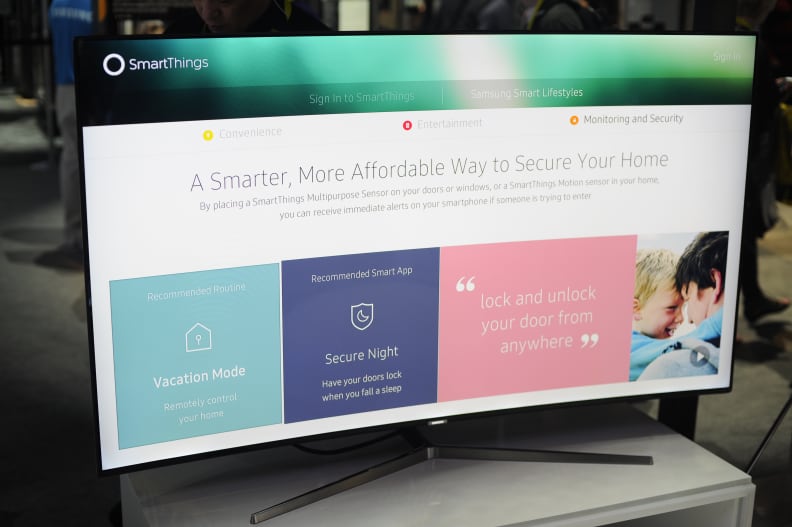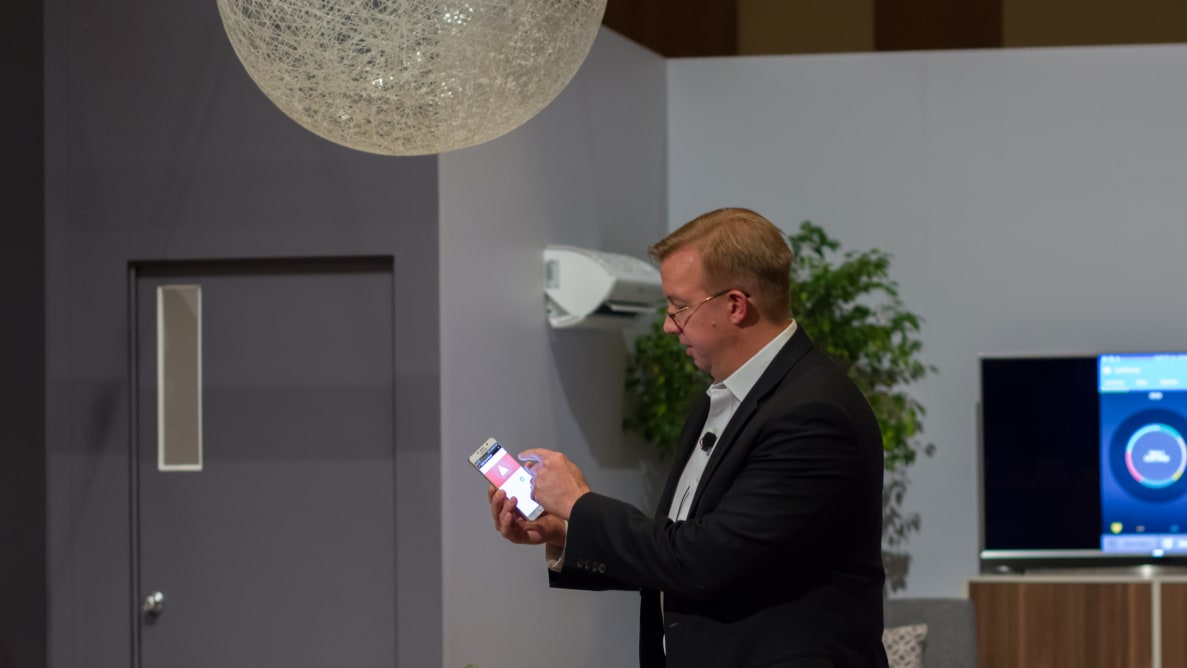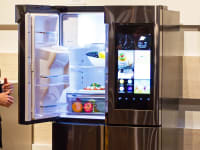From Samsung's entire 2016 smart TV lineup to BMWs with ConnectedDrive, more and more products are being integrated with SmartThings—the smart home startup that Samsung sees as integral to the future of its electronics business.
We weren't able to get hands-on time with all of Samsung's latest connected products (the smart TV integration wasn't being demoed), but here's a rundown on how all of these new integrations and products will work as they're released throughout 2016.
Smart TVs
Even though Samsung wasn't demoing the SmartThings TV integration, the company did have one curved TV in its booth showing a new SmartThings menu, which will likely be part of the app that the TVs ship with. Samsung Executive Vice President Joe Stinziano said the new 2016 SUHD models that act as SmartThings hubs will start rolling out in just two months.
These TVs will work in place of standalone hubs, which have been a hard sell for many shoppers interested in smart home tech. In order to get the full-range of product support, these SUHD TVs will need a free SmartThings Extend USB stick, which will allow them to work with products that communicate over Z-Wave and ZigBee.

New 2016 Samsung SUHD TVs will be able to act as SmartThings hubs.
It's unclear why the company is putting the radios in a USB stick instead of just building them into the TVs, but a possible explanation could be that it's cheaper to manufacture the TVs without integrating the extra hardware.
The rest of the company's non-SUHD 2016 smart TVs will feature SmartThings apps, but they won't be able to act as hubs since they lack the necessary hardware.
Appliances
Here's where Samsung is really keeping B.K. Yoon's promise from last year. At CES, the company showed off its new Family Hub smart fridge and four new Flex Duo ovens with WiFi built in, and also announced that many of its products will soon be controllable from the SmartThings app.
Connecting All the Appliances
SmartThings integration is coming to Samsung appliances both new and old. A SmartThings representative informed me that 16 appliances will be integrated, though most of them are variants of a single oven.
Four variants of the new Family Hub refrigerator will be connected, as will seven new variants of the Flex Duo ovens with WiFi, which we will go into shortly. Three variants of the new PowerBot robot vacuum will also be connected, along with two 2014 dryers—the DV457EVGSGR and DV457EVGSWR.

The Samsung Family Hub smart fridge has a 21.5-inch touchscreen.
During the show, Samsung demoed the new smart ovens with Samsung's old Smart Home app, not the SmartThings app. However, SmartThings integrations should be available when the ovens go on sale. A SmartThings representative said that consumers will be able to control Samsung smart appliances from both apps for "added flexibility."
Flex Duo Ranges with WiFi
Though overshadowed by the Family Hub fridge, the new Flex Duo ovens with WiFi were a big focus for Samsung at the show. There are four new models: a $2,999 electric range, a $3,299 gas range, a $2,999 freestanding gas range, and a $2,799 induction range. All but the induction range are Dual Door models, and come in Black Stainless for an extra $100.
All of the ovens can be controlled from both the Samsung Smart Home and SmartThings apps. That means you can monitor (not control) which burners are on or off, and control the temperature and cook time for the oven. All of the ovens with the exception of the gas oven can even be started remotely, while all four can be shut off remotely. In order to remotely control the ovens, you have to press the Smart Control button on each range.
{{ photo_gallery name="Samsung Flex Duo Ranges with WiFi" }}
I tried the remote control features myself and they were fairly responsive—not instantaneous, but quick enough. The cooktop monitoring feature also works quite well, showing the burners that are on in blue and the rest in gray. You can't control the burners due to safety concerns, but I do wish there was a way to remotely shut them off in case you accidentally left them on.
Regardless, these smart features actually seem quite compelling, and will make for great additions to a line of ranges that were already quite good to begin with.
Apps for Everything
{{amazon name="Samsung Gear S2 Smartwatch", asin="B015JQ60NA", align="right"}} SmartThings was also quite busy on the software side of things, building new apps for BMW and the Samsung Gear S2, as well as integrating with ADT Canopy.
With the ADT integration, SmartThings owners will be able to use their devices with a well-known security service. The $20 service is month-to-month with no contract, making it easy to start and stop as you wish. Subscribers get access to an in-app panic button, as well as home monitoring using the sensors they already have in their homes.
The upcoming SmartThings app for the Gear S2 will give users complete control of their home from their wrist. SmartThings already has apps for the original Gear S and even the Apple Watch, so it's a no-brainer to build an app for Samsung's latest smartwatch.
BMW ConnectedDrive
Perhaps one of the coolest integrations on display was Samsung's new SmartThings app for BMW vehicles with ConnectedDrive that came out after July 2013. The app is already available to Android users, and iPhone owners will get it soon.
On Android, you need to have installed and set up both the SmartThings and BMW ConnectedDrive apps. Then, you simply plug your Android phone into the car and access the car's new SmartThings app, which should appear under BMW Apps on the display.
{{ photo_gallery name="SmartThings for BMW" }}
The new app is responsive and surprisingly feature-rich. You can access Samsung's Smart Home Monitor, view alerts, open and close your garage door, see if family members are home, activate routines, and even access other properties (for example, a vacation home). It's worth noting that the demo wasn't actually connected to a real home, so it's unclear just how well these functions actually work in the wild.
A representative from BMW also showed me a non-working prototype SmartThings integration for the BMW i3 we were sitting in, which will allow you to unlock the doors, activate the car horn, preconfigure the HVAC system, and flash the lights, all from the SmartThings app on your phone.
The Smart Home Dream
Samsung now has one of the best smart home ecosystems around, with a number of compatible products that is quickly eclipsing its fiercest competitors. This year's CES announcements will only further increase the company's lead in the smart home space.
While the company is keeping B.K. Yoon's promise, I can't help wondering how it will affect SmartThings CEO Alex Hawkinson's dream for the platform. He has always spoken of making the SmartThings ecosystem as open as possible, so any manufacturer can integrate its products and give consumers more choice.
Now that Samsung is integrating all of its appliances, I doubt competing appliance manufacturers will opt to integrate with SmartThings over an ecosystem like Wink, which isn't a direct rival. If the smart home is ever going to go truly mainstream, appliance manufacturers have to let their products talk to those made by their competitors.
Few people will ever outfit their homes exclusively with Samsung products, or Whirlpool products, or Electrolux products. And unless these companies can work together, I fear Hawkinson's dream will never become a reality.
And even if the industry can overcome that hurdle, there's still the question of security. A system that can access someone's car, turn on their oven, and lock their doors will be a very tempting target for hackers. Companies like Samsung and Nest are going to have to start taking these concerns seriously, and it would be wise if they did it before someone's home gets hacked.
Still, these announcements are quite promising. We're finally seeing the death of the standalone smart home hub, the integration of cars and appliances, and even more ways to access and control our homes. The smart home is still far from perfect, but integrations like these will help us get there.
Related Video
{{brightcove '4692466427001'}}
Meet the tester
Daniel Wroclawski is a tech-obsessed editor and reporter. In his spare time, you can probably find him hurtling through the air in a tin can-sized airplane.
Checking our work.
Our team is here for one purpose: to help you buy the best stuff and love what you own. Our writers, editors, and lab technicians obsess over the products we cover to make sure you're confident and satisfied. Have a different opinion about something we recommend? Email us and we'll compare notes.
Shoot us an email




